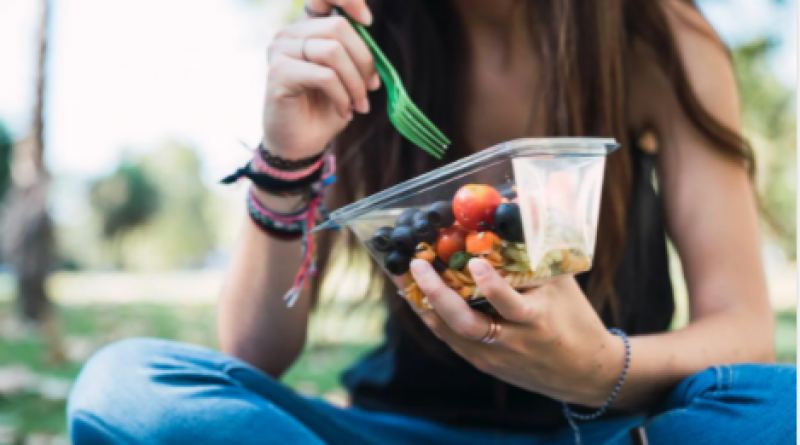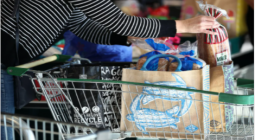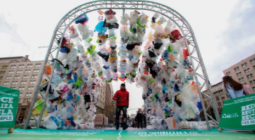Here's What Happens When You Eat From Plastic Containers.

Drinking water is supposed to be good for you, but what happens when you diligently carry that disposable water bottle around all day, to remind yourself to take a sip? With that sip, you take in an undue amount of plastic, according to recent research. And that's not all.
Takeout cartons, shelf-stable wrapping, those water bottles, even canned goods can be the culprit. And while no one likes the idea of consuming plastic, most of us still shrug and throw that container in the microwave.
4 Reasons Not to Eat or Drink From Plastic Containers:
1. The plastic transfers from the containers to your food.
Humans ingest at least 74,000 particles of microplastic a year, according to research in The Journal of Food Science. A lot of this comes from our takeout containers. In fact, we could be ingesting more than 200 particles a week, just from our plastic food storage units.
Microplastics from the containers themselves flake off into the food, accounting for 30 percent of the plastic intake from those foods, according to a study in The Journal of Hazardous Materials.
If you must do takeout, stop reusing your containers! Invest in glass or porcelain storage for your food. Keep in mind that the manufacturers set the dishwasher and microwave safe labels on your containers, not a governmental regulatory body like the FDA. You are trusting large corporations, often based outside of the United States, to tell you your food containers are safe to wash and to heat — they may not be.
And it's not just takeout. Ditch that plastic water bottle. High heat breaks the chemical bonds in plastic, increasing the microplastic shedding. Researchers have found that water bottles left out in the sun have a higher number of plastic chemicals in them.
2. Microplastics are bad for you.
We're ingesting plastics, so what? They don't just make their way through our system and out of our bodies. They can stay with us.
Scientists have found that microplastics can cross the hardy membrane that protects the brain from foreign bodies in the bloodstream, at least in animals. They are carcinogenic to humans.
Just as troubling, mothers may pass microplastics through the placenta to their fetuses, according to a study shared at Rutgers Center for Urban Environmental Sustainability.
The chemicals leaching out of these plastics can cause long-term medical effects. The particles could release phthalates into the body, which interfere with hormones and can reduce fertility in both men and women. The Consumer Product Safety Improvement Act of 2008 banned use of phthalates in toys, formula and bottles.
3. There is no such thing as safe plastic.
It's not just the phthalates. Plastics contain multitudes of chemicals, including bisphenols A, S and F (BPAs, BPSs, and BPFs), and polychlorinated biphenyls (PCBs).
Chemicals like these have been linked to cancers, weakened immune systems, organ problems, and developmental delays in kids. Bisphenols specifically (particularly BPA) have been identified as endocrine-disrupting and linked to obesity. Research also shows that BPAs make it more difficult for women to conceive and increase the risk of miscarriages.
You may notice plastics in the grocery store (like bottles, for instance) being marketed as BPA-free. While that's great, still beware! In place of BPA, many companies are substituting BPS which, like BPA, mimics estrogen. A BPA-free label is not enough for safety.
No matter what the compounds are, none have yet been proven safe for human consumption, and consume them is what we end up doing when we use plastic containers.
4. These containers are bad for the environment.
We are literally filling our world with plastic garbage. Since plastic came into common use in the 1950s, we have produced more than 8 billion tons of it. Only 10 percent of that, at most, has been recycled.
There is so much plastic surrounding us that we breathe in tens of thousands of minuscule plastic particles a year. Plastic is in our rivers and oceans — not just in the visible trash we throw out that ends up there, but in the micro-world, with filaments leached into our food and water sources.
Even recycling can't help. Studies have found that recycling can introduce hazardous chemicals into other materials, meaning our best option is to stop producing plastic containers. How do we do that? Stop buying them.
What Can You Do?
The production and consumption of plastics show no sign of slowing, even with all the drawbacks. Still, with intention, you can buck this trend, live a healthier life and help our planet. Here's what you can do to minimize the amount of plastic you eat:
- Drink from reusable stainless steel or glass water bottles — plastic water bottles are a key villain in the microplastics fight.
- Transfer takeout to ceramic or glass dishware immediately — the sooner your food is away from the plastic, the fewer microplastics shed into it.
- Do not microwave plastics or put them in the dishwasher — high heat can exacerbate microplastic shedding.
- Vacuum and dust your house regularly — there is so much plastic in the environment that these particles make it into the dust in our homes; keeping it cleaner will keep our air cleaner, too.
With Plastic-Free July upon us, why not see if you can alter your habits, and improve your life.
Darlena Cunha is a freelance writer and a professor at the University of Florida, with degrees in communications and ecology.
1 July 2021
EcoWatch




